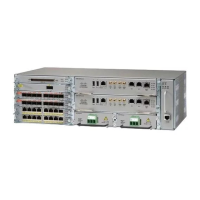4
Cisco IOS XE 3S Release Notes for the Cisco ASR 903 Router
OL-26630-08
Chapter
Limitations and Restrictions
• Multicast is not supported on POS, MLPPP and OC-12 interfaces.
• MPLS is supported only on PoS and MLPPP interfaces; MPLS on T1/E1 links is not supported.
• IP-FRR and BFD-triggered FRR are not supported on MPLS over POS links.
• Fragmentation is not supported with Multicast traffic on PoS interfaces.
• QoS is not supported with Multicast traffic on PoS interfaces.
• QoS is supported on POS interfaces on optical interface module.
• Three-level QoS policies are not supported on OC-3/OC-12 serial, MLPPP, and PoS interfaces. You
can only apply QoS policies on two levels on these interfaces.
Pseudowire/AToM Limitation
• The Cisco ASR 903 Router supports ATM over MPLS N-to-one cell mode for a single ATM Virtual
Channel Connections (VCCs) or Permanent Virtual Circuits (PVCs) to a pseudowire, but does not
support mapping to multiple VCCs or PVCs.
• The Cisco ASR 903 Router does not support ATM over MPLS one-to-one cell mode.
• The Cisco ASR 903 Router supports pseudowire ping using the CW method; pseudowire ping using
the TTL method is not supported.
• The Cisco ASR 903 Router supports a maximum of 2000 pseudowires in any combination.
The following pseudowire (PW) features are supported over MPLS-TP connections:
• ATM over MPLS PWs
• ATM attachment circuits
• AAL5 Encapsulation
• ATM VC Class Support
• Cell Relay including VC mode, VP mode, and Packed Cell Relay
• CESoPSN
• L2VPN pseudowire redundancy
• Multi-segment PWs
• PW OAM/Status TLV Support
• PW Redundancy
• SAToP
The following pseudowire (PW) features are not supported over MPLS-TP connections:
• ATM OAM Cell Emulation for ATM AAL5 over MPLS on PVC and in VC Class.
• BFD / VCCV over ATM AC over MPLS TP
• BFD/ VCCV over TDM PW over MPLS TP Manageability
• Ethernet VLAN to Ethernet VLAN L2VPN interworking (bridged and routed modes)
• Ethernet VLAN to ATM AAL5 L2VPN Interworking (bridged and routed modes)
• Ethernet port to ATM AAL5 PVC L2VPN Interworking (bridged and routed modes)
• Layer 2 QoS features such as classifying or marking based on an L2 value
• MIB support including PW-TDM-MIB, PW-ATM-MIB, and PW-CESOPSN-MIB
• N:1 PVC Mapping with non-unique VPI (N>1)

